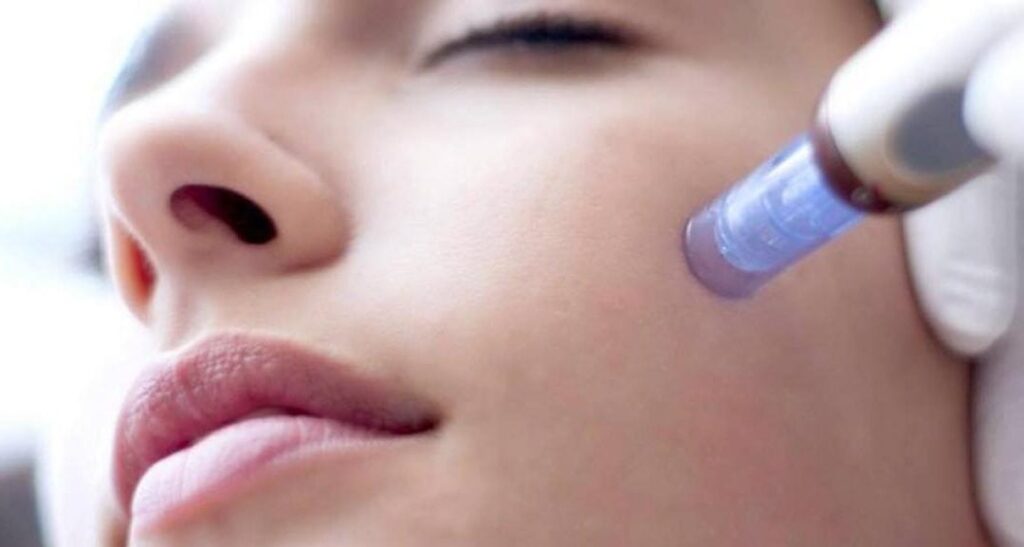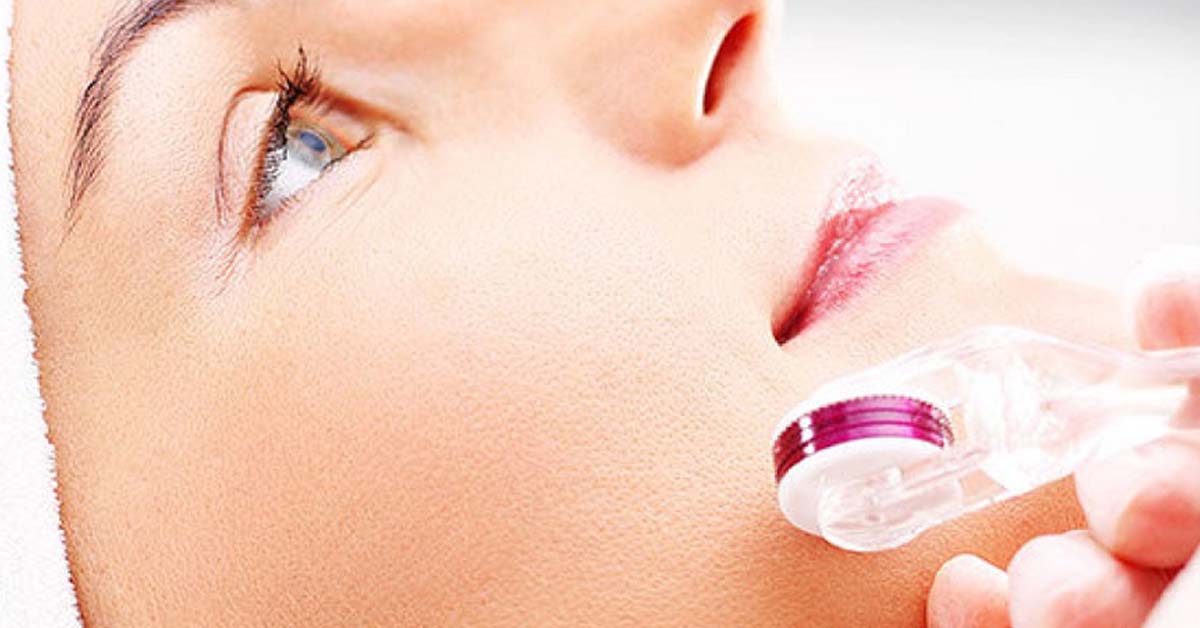Microneedling is a minimally invasive medical technique that uses microscopic needles to tackle various underlying skin conditions. Initially, it was used for the regeneration of skin, but over the past decade, the technology has improved remarkably and therefore diversified. Now it can be used to treat conditions like acne, scars, pores, wrinkles, stretch marks, and most importantly, what we are going to discuss today; oily skin.
Microneedling for oily skin has displayed exceptional success. It works by poking the skin numerous times with multiple tiny needles. This results in a reduction in the size of pores, which are the major factor contributing to oily skin. But what actually happens when you go through the procedure? What do you need to consider before the procedure and is it really worth it? In this article, we intend to answer all of your questions regarding micro-needling for oily skin.
What Is Microneedling For Oily Skin?

Microneedling for oily skin can be described as a cosmetic procedure that’s minimally invasive (any technique that operates the body with minimal damage). The technique utilizes the body’s ability to heal and repair wounds and restore dead cells. It targets collagen and elastin to trigger the regeneration of the molecules.
Professional microneedling for oily skin takes about 10 to 15 minutes however, depending on the area it may take longer. A professional dermaroller is used while the patient is under the influence of anesthesia. Multiple sessions are held, according to the skin’s response, with intervals of about 3 to 8 weeks.
Microneedling for oily skin can be performed at home too. With the help of derma rollers and at-home microneedling kits. But it is a lot riskier and less effective than professional microneedling.
Why Should You Get Microneedling For Oily Skin?
Let us explain how microneedling tackles oily skin. With the use of microscale needles, several areas of skin are pierced. When the body repairs the punctures, it also produces elastin and collagen.
Elastin is a biological molecule that is vital for elasticity in the skin. Collagen much like elastin provides elasticity though its principal function is to strengthen and hydrate the skin. As the body starts to age, the production of elastin and collagen decreases. This results in less elastic and weaker skin and therefore pores are dilated and wrinkles form. Sebum is a natural oil produced by the skin to keep itself moisturized. Enlarged pores have been linked to increased sebum production. In case there is an excessive production of sebum it can fill up the dilated pores and clog them. Altogether, they contribute to worsening oily skin.
Microneedling contracts the size of sebaceous glands (the glands that produce sebum) and also lessen the size of dilated pores. Therefore it decreases sebum production and consequently, the greasy shiny look of the skin diminishes. It also eliminates the main cause of various types of acne, overall it ends up curing your oily skin and all the issues associated with it.
When coupled with other treatments like topical products it has an impressive effect. Microneedling intensifies the absorption of topical products by widening the pore. Products like hyaluronic acid and retinol both get deeper access to the depth of the skin and as a result help in curing oily skin.
Microneedling for oily skin also treats acne, spots, discolouration, and scars and also results in a youthful firm appearance of skin. It treats multiple conditions all at once!!!
What Skin Type Is Suitable For Microneedling?
Unfortunately, people with certain skin conditions like psoriasis and eczema are ineligible. Those who have recently had radiotherapy or have been active should avoid it too. Lastly, blood conditions and a history of skin scars are some factors that don’t fit the criteria.
As we always advise, before making any decision, especially regarding microneedling for oily skin at home, always consult with your dermatologist. The damage can be irreversible.
The Procedure And Cost Of Microneedling For Oily Skin
The cost primarily depends on the length and complexity of the session. It can cost from $200 to about $800. However, the cost of aftercare products and off days from work should be taken into consideration before planning to proceed with the procedure. In addition, it often requires small sessions for maintenance.
The procedure though sounds painful and tedious, is actually quite the opposite. Let’s start from the beginning. Before booking an appointment you must contact your dermatologist for advice on preparation for microneedling for oily skin, they may prohibit the use of certain medications and products e,g retinoid
Once you reach the clinic at your appointed time, the doctor will start by applying topical anesthesia to the areas to be treated 1 hour before the process. The skin is pulled taut by the dermatologist with one hand, while the other will be used to roll the dermaroller (quite different from home dermaroller) or electric tool in a set pattern that ensures every part has been covered and none has been covered twice. When consistent and combined bleeding starts, it signifies the procedure’s end.
Inflammation and redness are common after the ordeal. The area is treated with antiseptic and an ice pack to provide it with a soothing effect.
How To Do Microneedling For Oily Skin At Home
Before you decide to do microneedling for oily skin at home, you should be aware of the fact it’s not as effective as when done by a professional and is more dangerous. It won’t cure your oily skin as professional microneedling would, however, it may reduce the greasy appearance and result in a more radiant look.
Here we will briefly explain how to safely do microneedling at home!
Before you begin any procedure, you must sterilize your products and your skin. Read the instruction manuals provided with the dermaroller and sterilize the needles accordingly. With the help of a fragrance-free cleanser, cleanse the entire face to get rid of all the oil, makeup, and dust.
Next, apply a hyaluronic acid-based moisturizer or serum to provide a smooth surface for the dermaroller to roll on. The added fluid acts like a lubricant and reduces friction when using the dermaroller.
Next, you carefully select a satisfactory home dermaroller, we recommend The Derma Roller-Titanium 540 needles. This length of the needle primarily depends on the thickness of the skin. However at home, it should be under 0.5mm, and anything beyond that should only be handled by a professional.
You should always start with the smallest needle size and gradually increase it with every progressing session. Take the start point on your skin, and hold the device at a 90-degree angle. Roll the dermaroller on your cheeks, forehead, lips, chin, and neck. It is recommended you only roll 2 to 4 times in horizontal, vertical, and diagonal directions and not overdo it. Also, make sure not to run over pus-filled acne, if the acne bursts you will be transferring the bacteria from inside it all over the face.
To soothe the inflamed skin, reapply hyaluronic-based moisturizer or serum. The inflammation will disappear in about an hour, to cool it down you can use an ice pack.
What Happens After The Microneedling Process?
After microneedling for oily skin, inflammation, redness, and swelling of the treated area are pretty common. Sometimes the skin may become dry and flaky. Fortunately, these conditions are temporary and are expected to go away after 2 to 3 days. This is the body’s biological response to self-inflicted wounds. As it attempts to heal them, the supply of blood to affected areas is increased which results in redness.
You can continue attending school, your job, or any other daily activity, the next day! However, the skin will be vulnerable to all sorts of damage so strong chemicals and exposure to UVA/UVB light should be avoided during the first week of recovery.
It’s preferable to avoid using makeup until the skin has calmed down. Once the irritation lessens, minimal makeup can be used to cover up the bright aftereffect marks. As we have said before, microneedling for oily skin is a minimally invasive technique, the injuries aren’t as deep as in any other cosmetic surgery, consequently, the recovery time is shorter too and results are faster too. In fact, it has been reported to show results within a few weeks.
What To Do After Microneedling: Aftercare For Oily Skin
To ensure the effectiveness of the procedure and the safety of your skin, appropriate aftercare is crucial. The damage caused in case of carelessness can be irreversible, therefore let’s discuss some compulsory aftercare steps.
It’s important to keep the treated area clean, as the skin is extremely vulnerable and fragile. Warm water and fragrance-free cleanser for sensitive skin can be used to sterilize the skin. Being gentle is the key, any rough treatment of the skin can worsen the inflammation. Moisturizers and serums containing hyaluronic acid, antioxidants, and peptides should be applied to keep the dry skin soft, radiant, and hydrated which also encourages collagen and elastin production.
Some recommended serums and moisturizers:
- Cerave Hyaluronic Acid Serum
- Vichy LiftActiv Supreme 1.5% Hyaluronic Acid Face Serum
- CeraVe Moisturizing Cream
- PCA SKIN Rejuvenating Serum
Retinoid formula products and Vitamin C have adverse effects. Prolonged exposure to sunlight without the use of brand spectrum SPF with at least 30 to 40 SPF is highly discouraged. Great care must be taken to avoid scratching the skin and injuring it further. Some recommended broad-spectrum sunscreens for oily skin:
- Neutrogena Ultra Sheer Dry Touch Sunblock.
- EltaMD UV Clear SPF 46 Face Sunscreen
- Cetaphil PRO Oil Absorbing Moisturizer SPF 30
For the first 24 hours strong chemicals, swimming, steaming, and creams can all cause damage. You must follow the Precautions and aftercare steps provided by your practitioner.
In case of any harsh reaction or uncontrolled inflammation and redness, contact the dermatologist immediately.
The skin is expected to heal within 4 to 6 weeks depending on the severity of the previous condition.
How Effective Is Microneedling In Treating Oily Skin?
Many people who had microneedling have shared their experiences. After going through numerous reviews, we have concluded that it is pretty effective when done correctly. It decreased the look of wrinkles, age lines, and acne considerably. Moreover, it has treated multiple scars and hyperpigmentation and has also given a natural radiating glow to the skin. Most importantly, it has had great success in reducing sebum production (the main cause of oily skin). The skin ended up looking firmer and healthier.
Although in a fraction of the cases, it wasn’t quite as successful. Sometimes it ended up in permanent irreversible damage. It left the skin’s texture like that of “orange skin”. Sometimes it also caused discolouration and stiff and dry skin. However, it must be noted it was only in very rare cases with many factors at play.
Conclusion
After all the research, here’s the final verdict on if you should get microneedling for oily skin or not. If done by trustworthy professionals in a renowned clinic the risk decreases significantly. With proper aftercare and extensive research to educate yourself, it has been proven to decrease oily skin. It is one of the few treatments that has a cure for oily skin to such an extent and also has numerous added benefits. Therefore you should get the treatment as long as you are well-educated on your skin type. So go ahead, do your research and contact your dermatologist!!!


3 thoughts on “Microneedling For Oily Skin: Best Practice You Need To Know”